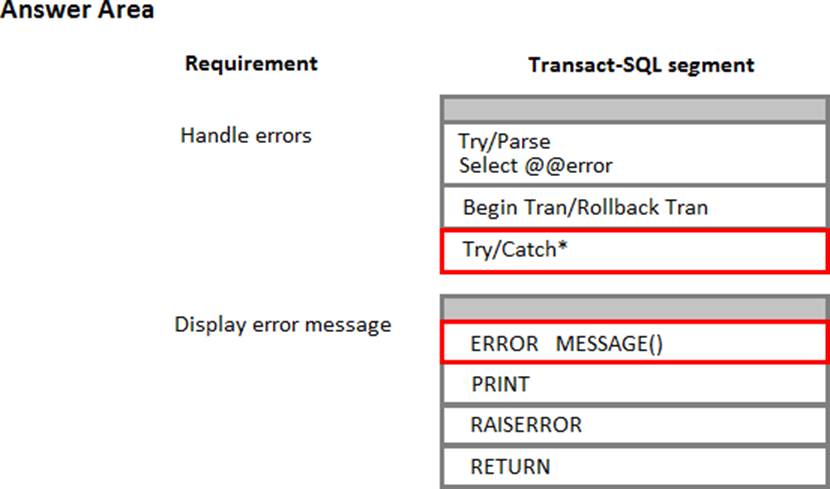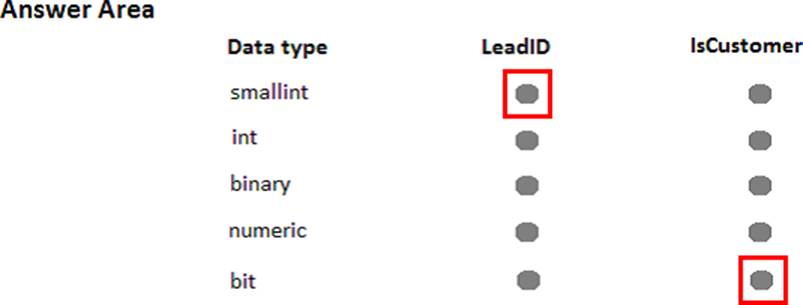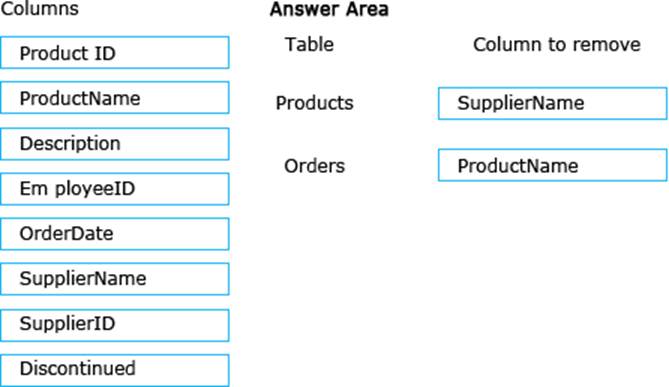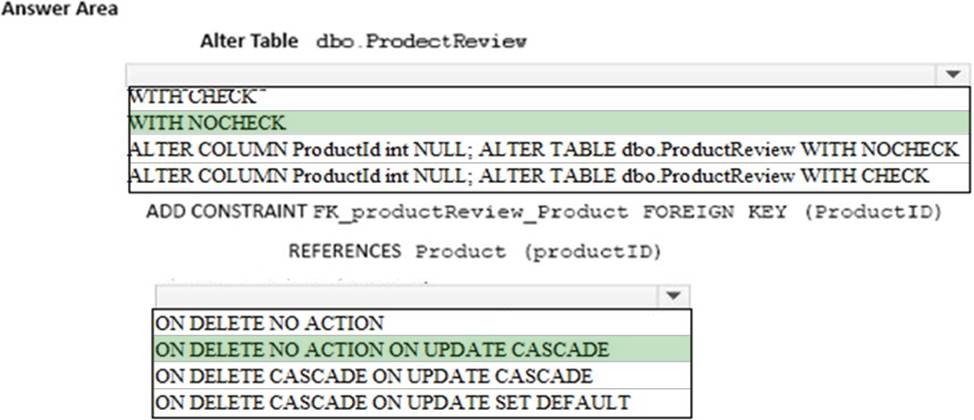Microsoft 70-762 Developing SQL Databases Online Training
Microsoft 70-762 Online Training
The questions for 70-762 were last updated at Dec 22,2025.
- Exam Code: 70-762
- Exam Name: Developing SQL Databases
- Certification Provider: Microsoft
- Latest update: Dec 22,2025
DRAG DROP
Note: This question is part of a series of questions that use the same scenario. For your convenience, the scenario is repeated in each question. Each question presents a different goal and answer choices, but the text of the scenario is exactly the same in each question in this series.
You have a database named Sales that contains the following database tables: Customer, Order, and Products. The Products table and the Order table are shown in the following diagram.
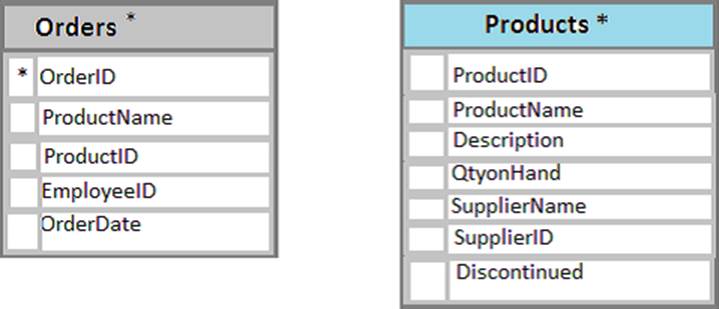
The customer table includes a column that stores the data for the last order that the customer placed.
You plan to create a table named Leads. The Leads table is expected to contain approximately 20,000 records. Storage requirements for the Leads table must be minimized.
Changes to the price of any product must be less a 25 percent increase from the current price. The shipping department must be notified about order and shipping details when an order is entered into the database.
You need to implement the appropriate table objects.
Which object should you use for each table? To answer, drag the appropriate objects to the correct tables. Each object may be used once, more than once, or not at all. You may need to drag the split bar between panes or scroll to view content.

HOTSPOT
Note: This question is part of a series of questions that use the same scenario. For your convenience, the scenario is repeated in each question. Each question presents a different goal and answer choices, but the text of the scenario is exactly the same in each question in this series.
You have a database named Sales that contains the following database tables: Customer, Order, and Products.
The Products table and the Order table are shown in the following diagram.
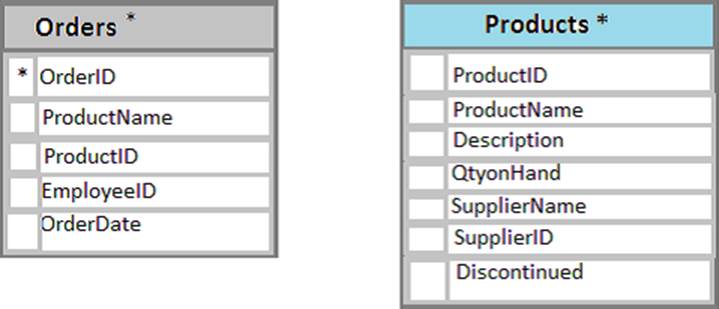
The customer table includes a column that stores the data for the last order that the customer placed.
You plan to create a table named Leads. The Leads table is expected to contain approximately 20,000 records. Storage requirements for the Leads table must be minimized.
You need to implement a stored procedure that deletes a discontinued product from the Products table. You identify the following requirements:
If an open order includes a discontinued product, the records for the product must not be deleted.
The stored procedure must return a custom error message if a product record cannot be deleted. The message must identify the OrderID for the open order.
What should you do? To answer, select the appropriate Transact-SQL segments in the answer area.
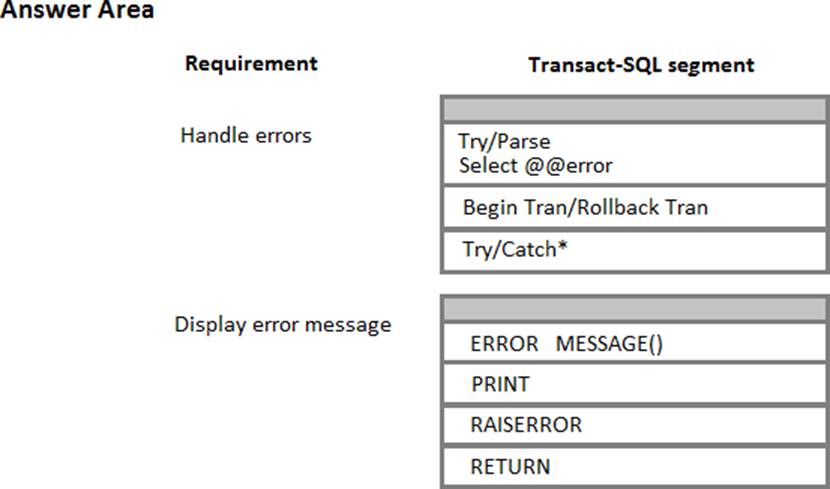
HOTSPOT
Note: This question is part of a series of questions that use the same scenario. For your convenience, the scenario is repeated in each question. Each question presents a different goal and answer choices, but the text of the scenario is exactly the same in each question in this series.
You have a database named Sales that contains the following database tables: Customer, Order, and Products.
The Products table and the Order table are shown in the following diagram.
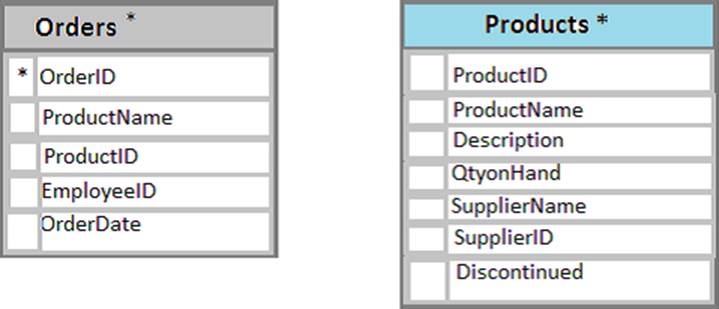
The customer table includes a column that stores the data for the last order that the customer placed.
You plan to create a table named Leads. The Leads table is expected to contain approximately 20,000 records. Storage requirements for the Leads table must be minimized.
You need to create triggers that meet the following requirements: Optimize the performance and data integrity of the tables. Provide a custom error if a user attempts to create an order for a customer that does not exist. In the Customers table, update the value for the last order placed. Complete all actions as part of the original transaction.
In the table below, identify the trigger types that meet the requirements. NOTE: Make only selection in each column. Each correct selection is worth one point.

HOTSPOT
Note: This question is part of a series of questions that use the same scenario. For your convenience, the scenario is repeated in each question. Each question presents a different goal and answer choices, but the text of the scenario is exactly the same in each question in this series.
You have a database named Sales that contains the following database tables: Customer, Order, and Products.
The Products table and the Order table are shown in the following diagram.
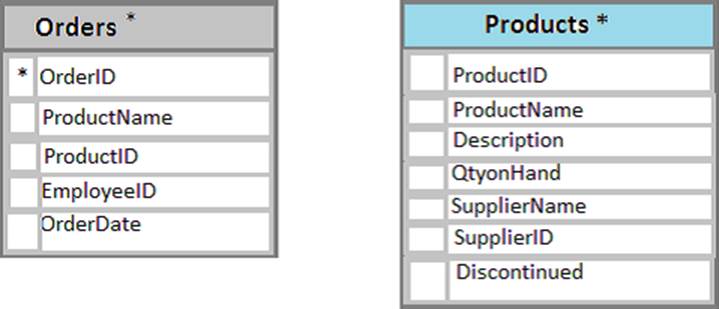
The customer table includes a column that stores the data for the last order that the customer placed.
You plan to create a table named Leads. The Leads table is expected to contain approximately 20,000 records. Storage requirements for the Leads table must be minimized.
The Leads table must include the columns described in the following table.

The data types chosen must consume the least amount of storage possible. You need to select the appropriate data types for the Leads table. In the table below, identify the data type that must be used for each table column. NOTE: Make only one selection in each column.
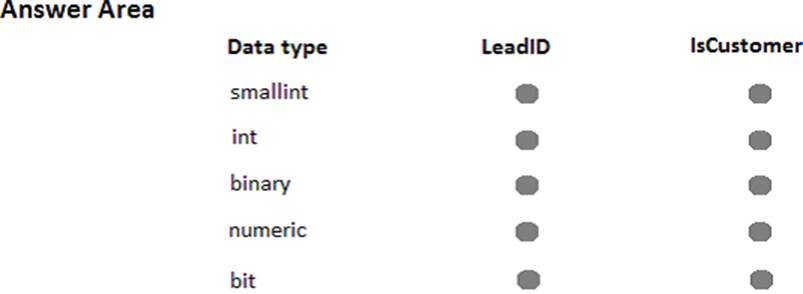
HOTSPOT
Note: This question is part of a series of questions that use the same scenario. For your convenience, the scenario is repeated in each question. Each question presents a different goal and answer choices, but the text of the scenario is exactly the same in each question in this series.
You have a database named Sales that contains the following database tables: Customer, Order, and Products.
The Products table and the Order table are shown in the following diagram.
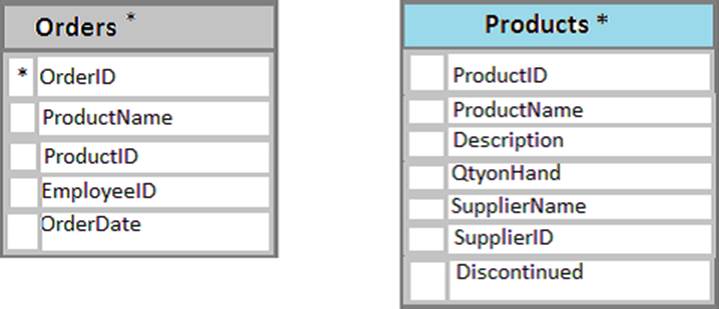
The customer table includes a column that stores the data for the last order that the customer placed.
You plan to create a table named Leads. The Leads table is expected to contain approximately 20,000 records. Storage requirements for the Leads table must be minimized.
You need to modify the database design to meet the following requirements:
– Rows in the Orders table must always have a valid value for the ProductID column.
– Rows in the Products table must not be deleted if they arepart of any rows in the Orders table.
– All rows in both tables must be unique.
In the table below, identify the constraint that must be configured for each table.
NOTE: Make only one selection in each column.

DRAG DROP
Note: This question is part of a series of questions that use the same scenario. For your convenience, the scenario is repeated in each question. Each question presents a different goal and answer choices, but the text of the scenario is exactly the same in each question in the series.
You have a database named Sales that contains the following database tables. Customer, Order, and Products.
The Products table and the order table shown in the following diagram.
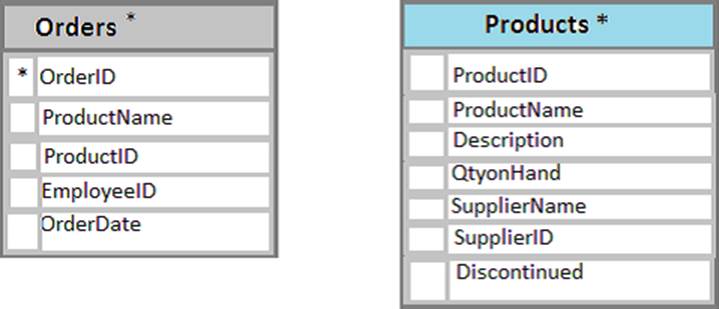
The Customer table includes a column that stores the date for the last order that the customer placed. You plan to create a table named Leads. The Leads table is expected to contain approximately 20,000 records. Storage requirements for the Leads table must be minimized.
You need to begin to modify the table design to adhere to third normal form.
Which column should you remove for each table? To answer? drag the appropriate column names to the correct locations. Each column name may be used once, more than once, or not at all. You may need to drag the split bar between panes or scroll to view content.
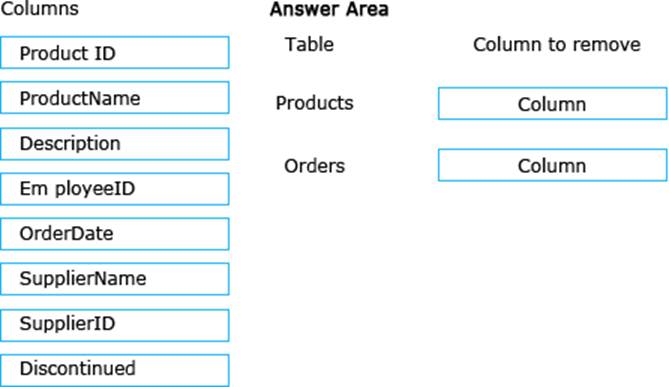
HOTSPOT
Note: This question is part of a series of questions that use the same scenario. For your convenience, the scenario is repeated in each question. Each question presents a different goal and answer choices, but the text of the scenario is exactly the same in each question in this series.
You have a database that contains the following tables: BlogCategory, BlogEntry, ProductReview, Product, and SalesPerson.
The tables were created using the following Transact SQL statements:
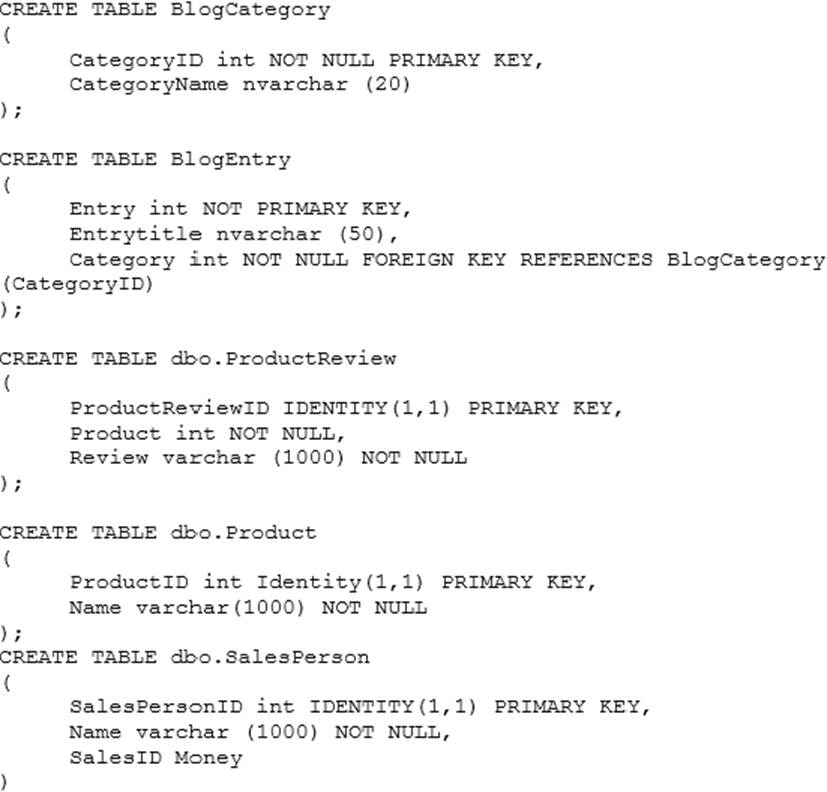
You must modify the ProductReview Table to meet the following requirements:
– The table must reference the ProductID column in the Product table
– Existing records in the ProductReview table must not be validated with the Product table.
– Deleting records in the Product table must not be allowed if records are referenced by the ProductReview table.
– Changes to records in the Product table must propagate to the ProductReview table.
You also have the following database tables: Order, ProductTypes, and SalesHistory, The transact-SQL statements for these tables are not available.
You must modify the Orders table to meet the following requirements:
– Create new rows in the table without granting INSERT permissions to the table.
– Notify the sales person who places an order whether or not the order was completed.
You must add the following constraints to the SalesHistory table:
– a constraint on the SaleID column that allows the field to be used as a record identifier
– a constant that uses the ProductID column to reference the Product column of the ProductTypes table
– a constraint on the CategoryID column that allows one row with a null value in the column
– a constraint that limits the SalePrice column to values greater than four
Finance department users must be able to retrieve data from the SalesHistory table for sales persons where the value of the SalesYTD column is above a certain threshold.
You plan to create a memory-optimized table named SalesOrder.
The table must meet the following requirements:
– The table must hold 10 million unique sales orders.
– The table must use checkpoints to minimize I/O operations and must not use transaction logging.
– Data loss is acceptable.
Performance for queries against the SalesOrder table that use Where clauses with exact equality operations must be optimized.
You need to enable referential integrity for the ProductReview table.
How should you complete the relevant Transact-SQL statement? To answer? select the appropriate Transact-SQL segments in the answer area.
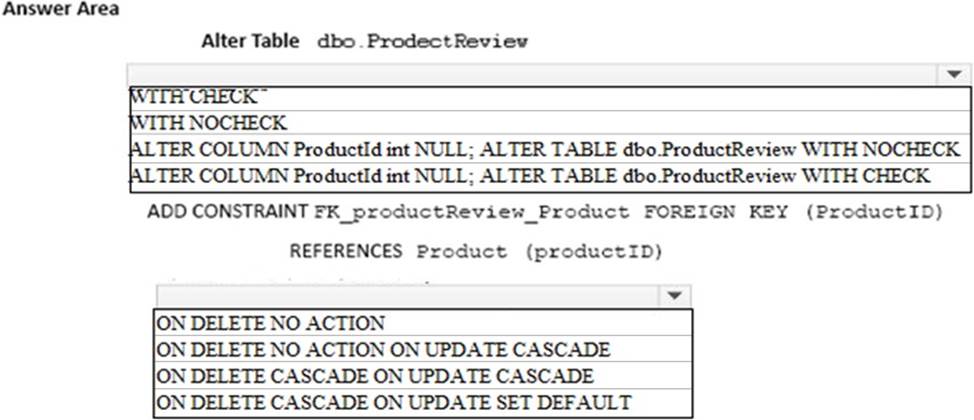
HOTSPOT
Note: This question is part of a series of questions that use the same scenario. For your convenience, the scenario is repeated in each question. Each question presents a different goal and answer choices, but the text of the scenario is exactly the same in each question in this series.
You have a database that contains the following tables: BlogCategory, BlogEntry, ProductReview, Product, and SalesPerson.
The tables were created using the following Transact SQL statements:

You must modify the ProductReview Table to meet the following requirements:
– The table must reference the ProductID column in the Product table
– Existing records in the ProductReview table must not be validated with the Product table.
– Deleting records in the Product table must not be allowed if records are referenced by the ProductReview table.
– Changes to records in the Product table must propagate to the ProductReview table.
You also have the following database tables: Order, ProductTypes, and SalesHistory, The transact-SQL statements for these tables are not available.
You must modify the Orders table to meet the following requirements:
– Create new rows in the table without granting INSERT permissions to the table.
– Notify the sales person who places an order whether or not the order was completed.
You must add the following constraints to the SalesHistory table:
– a constraint on the SaleID column that allows the field to be used as a record identifier
– a constant that uses the ProductID column to reference the Product column of the ProductTypes table
– a constraint on the CategoryID column that allows one row with a null value in the column
– a constraint that limits the SalePrice column to values greater than four
Finance department users must be able to retrieve data from the SalesHistory table for sales persons where the value of the SalesYTD column is above a certain threshold.
You plan to create a memory-optimized table named SalesOrder.
The table must meet the following requirements:
– The table must hold 10 million unique sales orders.
– The table must use checkpoints to minimize I/O operations and must not use transaction logging.
– Data loss is acceptable.
Performance for queries against the SalesOrder table that use Where clauses with exact equality operations must be optimized.
You need to enable referential integrity for the ProductReview table.
How should you complete the relevant Transact-SQL statement? To answer? select the appropriate Transact-SQL segments in the answer area.

HOTSPOT
Note: This question is part of a series of questions that use the same scenario. For your convenience, the scenario is repeated in each question. Each question presents a different goal and answer choices, but the text of the scenario is exactly the same in each question in this series.
You have a database that contains the following tables: BlogCategory, BlogEntry, ProductReview, Product, and SalesPerson.
The tables were created using the following Transact SQL statements:

You must modify the ProductReview Table to meet the following requirements:
– The table must reference the ProductID column in the Product table
– Existing records in the ProductReview table must not be validated with the Product table.
– Deleting records in the Product table must not be allowed if records are referenced by the ProductReview table.
– Changes to records in the Product table must propagate to the ProductReview table.
You also have the following database tables: Order, ProductTypes, and SalesHistory, The transact-SQL statements for these tables are not available.
You must modify the Orders table to meet the following requirements:
– Create new rows in the table without granting INSERT permissions to the table.
– Notify the sales person who places an order whether or not the order was completed.
You must add the following constraints to the SalesHistory table:
– a constraint on the SaleID column that allows the field to be used as a record identifier
– a constant that uses the ProductID column to reference the Product column of the ProductTypes table
– a constraint on the CategoryID column that allows one row with a null value in the column
– a constraint that limits the SalePrice column to values greater than four
Finance department users must be able to retrieve data from the SalesHistory table for sales persons where the value of the SalesYTD column is above a certain threshold.
You plan to create a memory-optimized table named SalesOrder.
The table must meet the following requirements:
– The table must hold 10 million unique sales orders.
– The table must use checkpoints to minimize I/O operations and must not use transaction logging.
– Data loss is acceptable.
Performance for queries against the SalesOrder table that use Where clauses with exact equality operations must be optimized.
You need to enable referential integrity for the ProductReview table.
How should you complete the relevant Transact-SQL statement? To answer? select the appropriate Transact-SQL segments in the answer area.

HOTSPOT
Note: This question is part of a series of questions that use the same scenario. For your convenience, the scenario is repeated in each question. Each question presents a different goal and answer choices, but the text of the scenario is exactly the same in each question in this series.
You have a database that contains the following tables: BlogCategory, BlogEntry, ProductReview, Product, and SalesPerson.
The tables were created using the following Transact SQL statements:

You must modify the ProductReview Table to meet the following requirements:
– The table must reference the ProductID column in the Product table
– Existing records in the ProductReview table must not be validated with the Product table.
– Deleting records in the Product table must not be allowed if records are referenced by the ProductReview table.
– Changes to records in the Product table must propagate to the ProductReview table.
You also have the following database tables: Order, ProductTypes, and SalesHistory, The transact-SQL statements for these tables are not available.
You must modify the Orders table to meet the following requirements:
– Create new rows in the table without granting INSERT permissions to the table.
– Notify the sales person who places an order whether or not the order was completed.
You must add the following constraints to the SalesHistory table:
– a constraint on the SaleID column that allows the field to be used as a record identifier
– a constant that uses the ProductID column to reference the Product column of the ProductTypes table
– a constraint on the CategoryID column that allows one row with a null value in the column
– a constraint that limits the SalePrice column to values greater than four
Finance department users must be able to retrieve data from the SalesHistory table for sales persons where the value of the SalesYTD column is above a certain threshold.
You plan to create a memory-optimized table named SalesOrder.
The table must meet the following requirements:
– The table must hold 10 million unique sales orders.
– The table must use checkpoints to minimize I/O operations and must not use transaction logging.
– Data loss is acceptable.
Performance for queries against the SalesOrder table that use Where clauses with exact equality operations must be optimized.
You need to enable referential integrity for the ProductReview table.
How should you complete the relevant Transact-SQL statement? To answer? select the appropriate Transact-SQL segments in the answer area.

Latest 70-762 Dumps Valid Version with 157 Q&As
Latest And Valid Q&A | Instant Download | Once Fail, Full Refund


